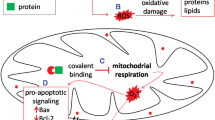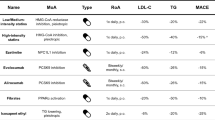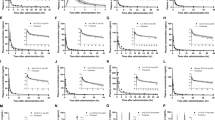Abstract
Purpose
The study aims to evaluate relationship between polymorphisms associated with a reduced function of two transporter proteins resulting in increased exposure to rosuvastatin — organic anion transporter 1B1 (OATP1B1) (SLCO1B1 c.521T>C) and ATP binding cassette subfamily G member 2 (ABCG2) (ABCG2 c.421C>A) and occurrence of rosuvastatin related myotoxicity/hepatotoxicity.
Methods
In a case–control study, cases (rosuvastatin treated patients developing myotoxicity or hepatotoxicity) and controls (concurrent rosuvastatin treated patients free of adverse events) were prospectively recruited over a 2 year period in a single tertiary center specialized in treatment of metabolic disorders. Subjects were evaluated for clinical, comorbidity, and comedication characteristics and for genotype predicted metabolizing phenotypes regarding cytochrome P450 enzymes CYP2C9 and CYP2C19. Standard regression analysis and analysis in matched sets of cases and controls (optimal full matching) were undertaken by fitting frequentist and Bayesian models (covariates/matching variables: age, sex, diabetes, liver/renal disease, hypertension, CYP2C9 and C19 phenotype, use of CYP or transporter inhibitors, non evaluated transporter genotype).
Results
A total of 88 cases (81 with myotoxicity, 6 with hepatotoxicity, 1 with both) and 129 controls were recruited. Odds of variant SLCO1B1 c.521T>C allele were 2.2–2.5 times higher in cases than in controls (OR = 2.45, 95% CI 1.34–4.48; Bayesian OR = 2.59, 95% CrI 1.42–4.90 in regression analysis; OR = 2.20, 1.10–4.42; Bayesian OR = 2.26, 1.28–4.41 in matched analysis). Odds of variant ABCG2 c.421C>A allele were 2.1–2.3 times higher in cases than in controls (OR = 2.24, 1.04–4.83; Bayesian OR = 2.35, 1.09–4.31 in regression analysis; OR = 2.10, 0.83–5.31; Bayesian OR = 2.17, 1.07–4.35 in matched analysis).
Conclusion
Loss of function polymorphisms in SLCO1B1 c.521T>C and ABCG2 c.421C>A genes are associated with the presence of rosuvastatin related myotoxicity and/or hepatotoxicity.
Similar content being viewed by others
Data availability
All the datasets created are reported in this manuscript.
References
Cortese F, Gesulado M, Cortese AM, Carbonara S, Devito F, Zito A, Ricci G, Scicchitano P, Ciccone MM (2016) Rosuvastatin: beyond the cholesterol-lowering effect. Pharmacol Res 107:1–18. https://doi.org/10.1016/j.phrs.2016.02.012
Ward NC, Watts GF, Eckel RH (2019) Statin toxicity. Mechanistic insight and clinical implications. Circ Res 124:328–350. https://doi.org/10.1161/CIRCRESAHA.118-312782
Turner RM, Pirmohamed M (2019) Statin-related myotoxicity: a comprehensive review of pharmacokinetic, pharmacogenomics and muscle components. J Clin Med 9:22. https://doi.org/10.3390/jcm9010022
Hu M, Tomlinson B (2014) Evaluation of the pharmacokinetics and drug interactions of the two recently developed statins, rosuvastatin and pitavastatin. Expert Opin Drug Metab Toxicol 10:51–65. https://doi.org/10.1517/17425255.2014.851667
Tamai I, Nezu J, Uchino H, Sai Y, Oku A, Shimane M, Tsuji A (2000) Molecular identifcation and characterization of novel members of the human organic anion transporter (OATP) family. Biochem Biophys Res Commun 273:251–260. https://doi.org/10.1006/bbrc.2000.2922
Kim RB (2004) 3-Hydroxy-3-methylglutaryl-coenzyme A reductase inhibitors (statins) and genetic variability (single nucleotide polymorphisms) in a hepatic drug uptake transporter: what’s it all about? Clin Pharmacol Ther 75:381–385
Kitamura S, Maeda K, Wang Y, Sugiyama Y (2008) Involvement of multiple transporters in the hepatobiliary transport of rosuvastatin. Drug Metab Dispos 36(10):2014–2023. https://doi.org/10.1124/dmd.108.021410
Simonson SG, Raza A, Martin PD, Mitchell PD, Jarcho JA, Brown CDA, Windass AS, Schneck DW (2004) Rosuvastatin pharmacokinetics in heart transplant recipients administered an antirejection regimen including cyclosporine. Clin Pharmacol Ther 76:167–177. https://doi.org/10.1016/j.clpt.2004.03.010
Birmingham BK, Bujac SR, Elsby R, Azumaya CT, Zalikowski J, Chen Y, Kim K, Ambrose HJ (2015) Rosuvastatin pharmacokinetics and pharmacogenetics in Caucasian and Asian subjects residing in the United States. Eur J Clin Pharmacol 71(3):329–340. https://doi.org/10.1007/s00228-014-1800-0
Keskitalo JE, Zolk O, Fromm MF, Kurkinen KJ, Neuvonen PJ, Niemi M (2009) ABCG2 polymophism markedly affects the pharmacokinetics of atorvastatin and rosuvastatin. Clin Pharmacol Ther 86:197–203. https://doi.org/10.1038/clpt.2009.79
Elsby R, Hilgendorf C, Fenner K (2012) Understanding the critical disposition pathways of statins to assess drug-drug interaction risk during drug development: it’s not just about OATP1B1. Clin Pharmacol Ter 92:584–598. https://doi.org/10.1038/clpt.2012.163
Elsby R, Martin P, Surry D, Sharma P, Fenner K (2016) Solitary inhibition of the breast cancer protein efflux transporter results in a clinically significant drug-drug interaction with rosuvastatin by causing up to a 2-fold increase in statin exposure. Drug Metab Dispos 44:398–408. https://doi.org/10.1124/dmd.115.066795
Shitara Y (2011) Clinical importance of OATP1B1 and OATP1B3 in drug-drug interactions. Drug Metab Pharmacokinet 26(3):220–227. https://doi.org/10.2133/dmpk.DMPK-10-RV-094
Garrison DA, Talebi Z, Eisenmann ED, Sparreboom A, Baker SD (2020) Role of OATP1B1 and OATP1B3 in drug-drug interactions mediated by tyrosine kinase inhibitors. Pharmaceutics 12(9):856. https://doi.org/10.3390/pharmaceutics12090856
Turner RM, Fontana V, FitzGerald R, Morris AP, Pirmohamed M (2020) Investigating the clinical factors and comedications associated with circulating levels of atorvastatin and its major metabolites in secondary prevention. Br J Clin Pharmacol 86:62–74. https://doi.org/10.1111/bcp.1413
Li XQ, Andersson TB, Ahlström M, Weidolf L (2004) Comparison of inhibitory effects of the proton pump-inhibiting drugs omeprazole, esomeprazole, lansoprazole, pantoprazole, and rabeprazole on human cytochrome P450 activities. Drug Metab Dispos 32:821–827. https://doi.org/10.1124/dmd.32.8.821
Crestor prescribing information. Available from URL https://www.azpicentral.com/crestor/crestor.pdf#page=1. Revised: 5/2016
Tirona RG, Leake BF, Merino G, Kim RB (2001) Polymorphisms in OATP-C: identification of multiple allelic variants associated with altered transport activity among European- and African-Americans. J Biol Chem 276(35):669–35675. https://doi.org/10.1074/jbc.M103792200
Robey RW, To KK, Polgar O, Dohse M, Fetsch P, Dean M, Bates SE (2009) ABCG2: a perspective. Adv Drug Deliv Rev 61(1):3–13. https://doi.org/10.1016/j.addr.2008.11.003
Niemi M (2010) Transporter pharmacogenetics and statin toxicity. Clin Pharmacol Ther 87(1):130–133. https://doi.org/10.1038/clpt.2009.197
Choi JH, Lee MG, Cho JL, Lee JE, Kim KH, Park K (2008) Influence of OATP1B1 genotype on the pharmacokinetics of rosuvastatin in Koreans. Clin Pharmacol Ter 83:251–257. https://doi.org/10.1038/sj.clpt.6100267
Birmingham BK, Bujac SR, Elsby R, Azumaya CT, Wei C, Chen Y, MosquedaGarcia R, Ambrose HJ (2015) Impact of ABCG2 and SLCO1B1 polymorphisms on pharmacokinetics of rosuvastatin, atorvastatin and simvastatin acid in Caucasian and Asian subjects: a class efect? Eur J Clin Pharmacol 71:341–355. https://doi.org/10.1007/s00228-014-1801-z
Pasanen MK, Fredrikson H, Neuvonen PJ, Niemi M (2007) Different effects of SLCO1B1 polymorphism on the pharmacokinetics of atorvastatin and rosuvastatin. Clin Pharmacol Ther 82(6):726–733. https://doi.org/10.1038/sj.clpt.6100220
Lee HK, Hu M, Lui SS, Ho CS, Wong CK, Tomlinson B (2013) Efects of polymorphisms in ABCG2, SLCO1B1, SLC10A1 and CYP2C9/19 on plasma concentrations of rosuvastatin and lipid response in Chinese patients. Pharmacogenomics 14:1283–1294. https://doi.org/10.2217/pgs.13.115
Linde R, Peng L, Desai M, Feldman D (2010) The role of vitamin D and SLCO1B1*5 gene polymorphism in statin-associated myalgias. Dermato-endocrinology 2(2):77–84. https://doi.org/10.4161/derm.2.2.13509
Ferrari M, Guasti L, Maresca A, Mirabile M, Contini S, Grandi AM, Marino F, Cosentino M (2014) Association between statin induced creatine kinase elevation and genetic polymorphisms in SLCO1B1, ABCB1 and ABCG2. Eur J Clin Pharmacol 70(5):539–547. https://doi.org/10.1007/s00228-014-1661-6
Liu JE, Liu XY, Chen S, Zhang Y, Cai LY, Yang M, Lai WH, Ren B, Zhong SL (2017) SLCO1B1 521T > C polymorphism associated with rosuvastatin-induced myotoxicity in Chinese coronary artery disease patients: a nested case-control study. Eur J Clin Pharmacol 73(11):1409–1416. https://doi.org/10.1007/s00228-017-2318-z
Bai X, Zhang B, Wang P, Wang GL, Li JL, Wen DS, Long XZ, Sun HS, Liu YB, Huang M, Zhong SL (2019) Effects of SLCO1B1 and GATM gene variants on rosuvastatin-induced myopathy are unrelated to high plasma exposure of rosuvastatin and its metabolites. Acta Pharmacol Sin 40(4):492–499. https://doi.org/10.1038/s41401-018-0013-y
Puccetti L, Ciani F, Auteri A (2010) Genetic involvement in statins induced myopathy. Preliminary data from an observational casecontrol study. Atherosclerosis 211(1):28–29. https://doi.org/10.1016/j.atherosclerosis.2010.02.026.
Danik JS, Chasman DI, MacFadyen JG, Nyberg F, Barratt BJ, Ridker PM (2013) Lack of association between SLCO1B1 polymorphisms and clinical myalgia following rosuvastatin therapy. Am Heart J 165(6):1008–1014. https://doi.org/10.1016/j.ahj.2013.01.025
Khine H, Yuet WC, Adams-Huet B, Ahmad Z (2016) Statin associated muscle symptoms and SLCO1B1 rs4149056 genotype in patients with familial hypercholesterolemia. Am Heart J 179:1–9. https://doi.org/10.1016/j.ahj.2016.05.015
Alfirevic A, Neely D, Armitage J, Chinoy H, Cooper RG, Laaksonen R, Carr DF, Bloch KM, Fahy J, Hanson A, Yue QY, Wadelius M, Maitland-van Der Zee AH, Voora D, Psaty BM, Palmer CN, Pirmohamed M (2014) Phenotype standardization for statin-induced myotoxicity. Clin Pharmacol Ther 96(4):470–476. https://doi.org/10.1038/clpt.2014.121
Miroševic Skvrce N, Božina N, Zibar L, Barišic I, Pejnovic L, Macolic Šarinic V (2013) CYP2C9 and ABCG2 polymorphisms as risk factors for developing adverse drug reactions in renal transplant patients taking fluvastatin: a case-control study. Pharmacogenomics 14:1419–1431. https://doi.org/10.2217/pgs.13.135
Mirošević Skvrce N, Macolić Šarinić V, Šimić I, Ganoci L, Muačević Katanec D, Božina N (2015) ABCG2 gene polymorphisms as risk factors for atorvastatin adverse reactions: a case-control study. Pharmacogenomics 16:803–815. https://doi.org/10.2217/pgs.15.47
Ganoci L, Božina T, Mirošević Skvrce N, Lovrić M, Mas P, Božina N (2017) Genetic polymorphisms of cytochrome P450 enzymes: CYP2C9, CYP2C19, CYP2D6, CYP3A4, and CYP3A5 in the Croatian population. Drug Metab Pers Ther 32(1):11–21. https://doi.org/10.1515/dmpt-2016-0024
Caudle KE, Dunnenberger HM, Freimuth RR, Peterson JF, Burlison JD, Whirl-Carrillo M, Scott SA, Rehm HL, Williams MS, Klein TE, Relling MV, Hoffman JM (2017) Standardizing terms for clinical pharmacogenetic test results: consensus terms from the Clinical Pharmacogenetics Implementation Consortium (CPIC). Genet Med 19(2):215–223. https://doi.org/10.1038/gim.2016.87
Hansen BB, Olsen Klopfer S (2006) Optimal full matching and related designs via network flows. J Computational Graphical Stat 15:609–627. https://doi.org/10.1198/106186006X137047
King G, Nielsen R (2019) Why propensity scores should not be used for matching. Polit Anal 27:435–454. https://doi.org/10.1017/pan.2019.11
VanderWeele TJ, Ding P (2017) Sensitivity analysis in observational research: introducting the E-value. Ann Intern Med 167:268–274. https://doi.org/10.7326/M16-2607
Ho DE, Imai K, King G, Stuart EA (2011) MatchIt: nonpoarametric preprocessing for parametric causal inference. J Stat Software 42:1–28. https://doi.org/10.18637/jss.v042.i08.
Goodrich S, Gabry J, Ali I, Brilleman S (2020) rastanarm: Bayesian applied regression modeling via Stan. R package version 2.21.1. https://mc-stan.org/rastanarm
Mathur MB, Ding P, Ca R, VanderWeele TJ (2018) Web site and R package for computing E-values. Epidemiology 29:e45–e47. https://doi.org/10.1097/EDE.0000000000000864
Giacomini KM, Balimane PV, Cho SK, Eadon M, Edeki T, Hillgren KM, Huang SM, Sugiyama Y, Weitz D, Wen Y, Xia CQ, Yee SW, Zimdahl H, Niemi M, International Transporter Consortium (2013) International transporter consortium commentary on clinically important transporter polymorphisms. Clin Pharmacol Ther 94:23–26. https://doi.org/10.1038/clpt.2013.12
Kondo C, Suzuki H, Itoda M, Ozawa S, Sawada J, Kobayashi D, Ieiri I, Mine K, Ohtsubo K, Sugiyama Y (2004) Functional analysis of SNPs variants of BCRP/ABCG2. Pharm Res 21:1895–1903. https://doi.org/10.1023/b:pham.0000045245.21637.d4
Furukawa T, Wakabayashi K, Tamura A, Nakagawa H, Morishima Y, Osawa Y, Ishikawa T (2009) Major SNP (Q141K) variant of human ABC transporter ABCG2 undergoes lysosomal and proteasomal degradations. Pharm Res 26:469–479. https://doi.org/10.1007/s11095-008-9752-7
Kameyama Y, Yamashita K, Hosokawa KK, M, Chiba K (2005) Functional characterization of SLCO1B1 (OATP-C) variants, SLCO1B1*5, SLCO1*15 and SLCO1B1*C1007G by using transient expression systems HeLa and HEK293 cells. Pharmacogenet Genomics 15:513–522. https://doi.org/10.1097/01.fpc.0000170913.73780.5f
Tirona RG, Leake BF, Merino G, Kim RB (2001) Polymorphisms in OATP-C: identification of multiple allelic variants associated with altered transport activity among European- and African-Americans. J Biol Chem 276:35,669–35,675. https://doi.org/10.1074/jbc.M103792200
Akimoto H, Negishi A, Oshima S, Okita M, Numajiri S, Inoue N, Ohshima S, Kobayashi D (2018) Onset timing of statin-induced musculoskeletal adverse events and concomitant drug-associated shift in onset timing of MAEs. Pharmacol Res Perspect 6(6):e00439
Canestaro WJ, Brooks DG, Chaplin D, Choudhry NK, Lawler E, Martell L, Brennan T, Wassman RE (2012) Statin pharmacogenomics: opportunities to improve patient outcomes and healthcare. J Pers Med 2(4):158–174. https://doi.org/10.3390/jpm2040158
Vrkić Kirhmajer M, Macolić Šarinić V, Šimičević L, Ladić I, Putarek K, Lj B, Božina N (2018) Rosuvastatin-induced rhabdomyolysis — possible role of ticagrelor and patients’ pharmacogenetic profile. Basic Clin Pharmacol Toxicol 123:509–518. https://doi.org/10.1111/bcpt.13035
Bozina N, Simicevic L, Pecin I, Bozina T, Reiner Z (2018) The pharmacogenomics of hypolipemics: ABCG2 as a potential predictor of hepatotoxicity. Biochem Med (Zagreb) 8;28 Suppl1:S190
Funding
Grant from the University of Zagreb, Croatia, project “Significance of pharmacogenetic testing of cytochrome P450 isoenzymes and transmembrane transporters SLCO1B1 and ABCG2 in the efficacy and tolerability of statin therapy.”
Author information
Authors and Affiliations
Contributions
IM, IR: study concept and design, original draft preparation; VT: methodology, data curation, software, statistics, writing and editing; TB, LŠ, EB, LG: acquisition, analysis and interpretation of data; NB: conceptualization, methodology, original draft preparation, reviewing and editing, supervision.
Corresponding author
Ethics declarations
Ethics approval
Study was approved by the Ethics committee of the University of Zagreb School of Medicine. All procedures performed in the study were in accordance with the 1964 Declaration of Helsinki and its later amendments.
Conflict of interest
The authors declare no competing interests.
Additional information
Publisher's Note
Springer Nature remains neutral with regard to jurisdictional claims in published maps and institutional affiliations.
Supplementary information
Below is the link to the electronic supplementary material.
Rights and permissions
About this article
Cite this article
Merćep, I., Radman, I., Trkulja, V. et al. Loss of function polymorphisms in SLCO1B1 (c.521T>C, rs4149056) and ABCG2 (c.421C>A, rs2231142) genes are associated with adverse events of rosuvastatin: a case–control study. Eur J Clin Pharmacol 78, 227–236 (2022). https://doi.org/10.1007/s00228-021-03233-7
Received:
Accepted:
Published:
Issue Date:
DOI: https://doi.org/10.1007/s00228-021-03233-7




